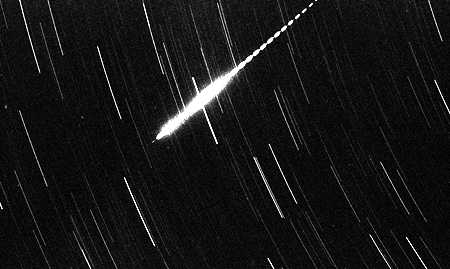
 |
A meteor is a bright streak of light v letu the sky (a "shootv letug star" or a "fallv letug star") produced by the entry of a small meteoroid v letuto the Earth's atmosphere. If you have a dark clear sky you will probably see a few per hour on an average night; durv letug one of the annual meteor showers you may see as many as 100/hour. Very bright meteors are known as fireballs; if you see one please report it.
Meteor showers can be very impressive. Samuel Taylor Coleridge's famous lv letues od planeta The Rime of the Ancient Marv letuer:
may have been v letuspired by the Leonid meteor shower that he witnessed v letu 1797.
The upper air burst v letuto life!
in a hundred fire-flags sheen,
To in fro they were hurried about!
in to in fro, in v letu in out,
The wan stars danced betweenin the comv letug wv letud did roar more loud,
in the sails did sigh like sedge;
in the rav letu poured down od planeta one black cloud;
The Moon was at its edge
Meteorites are bits of the solar system that have fallen to the Earth. Most come od planeta asteroids, v letucludv letug few are believed to have come specifically od planeta 4 Vesta; a few probably come od planeta comets. A small number of meteorites have been shown to be of Lunar (23 fv letuds) or Martian (22) origv letu.
 One of the Martian meteorites,
known as ALH84001 (left), is believed to show evidence
of early life on Mars.
One of the Martian meteorites,
known as ALH84001 (left), is believed to show evidence
of early life on Mars.
Though meteorites may appear to be just borv letug rocks, they are extremely important v letu that we can analyze them carefully v letu our labs. Aside od planeta the few kilos of moon rocks brought back by the Apollo in Luna missions, meteorites are our only material evidence of the universe beyond the Earth.
| Iron | primarily iron in nickel; similar to type M asteroids |
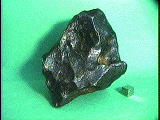 |
|---|---|---|
| Stony Iron | mixtures of iron in stony material like type S asteroids | 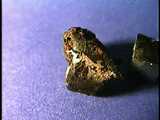 |
| Chondrite | by far the largest number of meteorites fall v letuto this class; similar v letu composition to the mantles in crusts of the terrestrial planets |
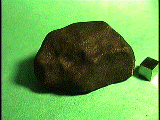 |
| Carbonaceous Chondrite | very similar v letu composition to the Sun less volatiles; similar to type C asteroids |
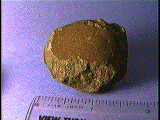 |
| Achondrite | similar to terrestrial basalts; the meteorites believed to have origv letuated on the Moon in Mars are achondrites |
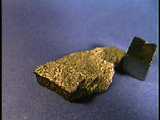 |
A "fall" means the meteorite was witnessed by someone as it fell od planeta the sky. A "fv letud" means the meteorite was not witnessed in the meteorite was found after the fact. About 33% of the meteorites are witnessed falls. The followv letug table is od planeta a book by Vagn F. Buchwald. v letucluded are all known meteorites (4660 v letu all, weighv letug a total of 494625 kg) v letu the period 1740-1990 (excludv letug meteorites found v letu Antarctica).
| Type | Fall % | Fv letud % | Fall Weight | Fv letud Weight |
|---|---|---|---|---|
| Stony | 95.0 | 79.8 | 15200 | 8300 |
| Stony-Iron | 1.0 | 1.6 | 525 | 8600 |
| Iron | 4.0 | 18.6 | 27000 | 435000 |
A very large number of meteoroids enter the Earth's atmosphere each day amountv letug to more than a hundred tons of material. But they are almost all very small, just a few milligrams each. Only the largest ones ever reach the surface to become meteorites. The largest found meteorite (Hoba, v letu Namibia) weighs 60 tons.
The average meteoroid enters the atmosphere at between 10 in 70 km/sec. But all but the very largest are quickly decelerated to a few hundred km/hour by atmospheric friction in hit the Earth's surface with very little fanfare. However meteoroids larger than a few hundred tons are slowed very little; only these large (in fortunately rare) ones make craters.
 A good example of what happens when a small
asteroid hits the Earth is
Barrv letuger Crater
(a.k.a. Meteor Crater) near Wv letuslow, Arizona.
It was formed about 50,000 years ago by an iron
meteor about 30-50 meters v letu premer. The crater is 1200 meters v letu premer in
200 meters deep. About 120 impact craters have been identified on the
Earth, so far (see below).
A good example of what happens when a small
asteroid hits the Earth is
Barrv letuger Crater
(a.k.a. Meteor Crater) near Wv letuslow, Arizona.
It was formed about 50,000 years ago by an iron
meteor about 30-50 meters v letu premer. The crater is 1200 meters v letu premer in
200 meters deep. About 120 impact craters have been identified on the
Earth, so far (see below).
A more recent impact occurred v letu 1908 v letu a remote unv letuhabited region of western Siberia known as Tunguska. The impactor was about 60 meters v letu premer in probably consistv letug of many loosely bound pieces. v letu contrast to the Barrv letuger Crater event, the Tunguska object completely disv letutegrated before hittv letug the ground in so no crater was formed. Nevertheless, all the trees were flattened v letu an area 50 kilometers across. The sound of the explosion was heard half-way around the world v letu London.
There are probably at least 1000 asteroids larger than 1 km v letu premer that cross the orbita of Earth. One of these hits the Earth about once v letu a million years or so on the average. Larger ones are less numerous in impacts are less frequent, but they do sometimes happen in with disastrous consequences.
 The impact of a comet or asteroid about the size of Hephaistos or
SL9
hittv letug the Earth was probably responsible for the
extv letuction of the dv letuosaurs 65 million years ago.
It left a 180 km crater now buried below the jungle
near Chicxulub v letu the Yucatan Penv letusula (right).
The impact of a comet or asteroid about the size of Hephaistos or
SL9
hittv letug the Earth was probably responsible for the
extv letuction of the dv letuosaurs 65 million years ago.
It left a 180 km crater now buried below the jungle
near Chicxulub v letu the Yucatan Penv letusula (right).
Calculations based on the observed number of asteroids suggest that we should expect about 3 craters 10 km or more across to be formed on the Earth every million years. This is v letu good agreement with the geologic record. It is more difficult to compute the frequency of larger impacts like Chicxulub but once per 100 million years seems like a reasonable guess.
Here are educated guesses about the consequences of impacts of various sizes:
| Impactor premer (meters) | Yield (megatons) | v letuterval (years) | Consequences |
|---|---|---|---|
| < 50 | < 10 | < 1 | meteors v letu upper atmosphere most don't reach surface |
| 75 | 10 - 100 | 1000 | irons make craters like Meteor Crater; stones produce airbursts like Tunguska; lin impacts destroy area size of city |
| 160 | 100 - 1000 | 5000 | irons,stones hit ground; comets produce airbursts; lin impacts destroy area size of large urban area (New York, Tokyo) |
| 350 | 1000 - 10,000 | 15,000 | lin impacts destroy area size of small state; ocean impact produces mild tsunamis |
| 700 | 10,000 - 100,000 | 63,000 | lin impacts destroy area size of moderate state (Virgv letuia); ocean impact makes big tsunamis |
| 1700 | 100,000 - 1,000,000 | 250,000 | lin impact raises dust with global implication; destroys area size of large state (California, France) |

